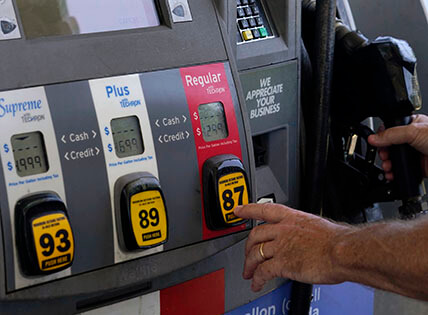
A customer pumps gas at an Exxon gas station, in Miami. U.S. consumers have so far defied higher prices for gas, food, and rent and have been spending more in 2022, providing crucial support to the economy.
Inflation is an increase in the prices of all goods and services over time. As prices increase, the purchasing power of money decreases. That is why a dollar today buys less than a dollar did in the past.
Sometimes the price of a good or service increases for a specific reason. For example, the price of orange juice might increase if orange crops are poor and there is less orange juice available. But with inflation, the prices of nearly all goods and services rise. However, inflation doesn’t mean prices rise exactly the same for all goods and services. The price of gas may rise by 17% in a year, while the cost of getting a haircut rises by 9% and the price of a bar of soap doesn’t rise at all.
With so many goods and services involved it is tricky to measure inflation. One way the government does this is by using a “basket” of goods and services to represent the spending of American consumers. The prices of about 94,000 goods and services from categories including food, housing, clothing, education, transportation, medical, and recreation are tracked in the basket. The overall price change of the basket over a period of time is the consumer price index, or CPI, and it is used as a common measure of inflation. In March 2022, the CPI jumped 8.5% from the previous year. This was the greatest yearly increase since 1981. Higher prices for gasoline, food, and rent contributed to the spike. Other factors like the war in Ukraine and supply chain issues have also had an impact.
Most economists believe a small amount of inflation is good for the economy. It can spur consumer demand and spending. Salaries and wages also increase to try and keep pace with inflation. But with high inflation consumers struggle to afford they things they need, and wages don’t keep up with price increases. In the United States, the Federal Reserve System acts as the central bank of the nation. By setting and changing interest rates, it aims to keep inflation at 2% or less.
There have been many periods of inflation throughout history. Perhaps the most memorable example of extreme inflation, or hyperinflation, was in Germany in 1923. After World War I, the German government printed enormous amounts of money to pay reparations. The value of the mark, Germany’s currency, fell rapidly and prices skyrocketed. Germans tried to spend their money quickly before it lost value. At the same time, more and more money was printed and prices shot higher and higher. During the peak of this cycle, some Germans carried marks in wheelbarrows to stores to pay for just a few goods. Others used marks as wallpaper, for crafts, or burned them as fuel because they had become so worthless.
Image credit: ©Marta Lavandier/AP Images
Sources
- US inflation jumped 8.5% in past year, highest since 1981
(Source: AP News; accessed May 27, 2022) - Reasons Why Inflation Is Good
(Source: The Balance; accessed May 27, 2022) - Inflation
(Source: Britannica Kids; accessed May 27, 2022) - Guide to Inflation
(Source: Investopedia; accessed May 27, 2022) - 1922-1923 Hyperinflation in Germany
(Source: Mashable; accessed May 27, 2022) - U.S. inflation rate in 2022
(Source: Official Data Foundation; accessed May 27, 2022) - Inflation rose at fastest pace in 40 years in March as consumer prices jumped 8.5%
(Source: USA Today; accessed May 27, 2022) - TED: The Economics Daily
(Source: U.S. Bureau of Labor Statistics; accessed May 27, 2022)



